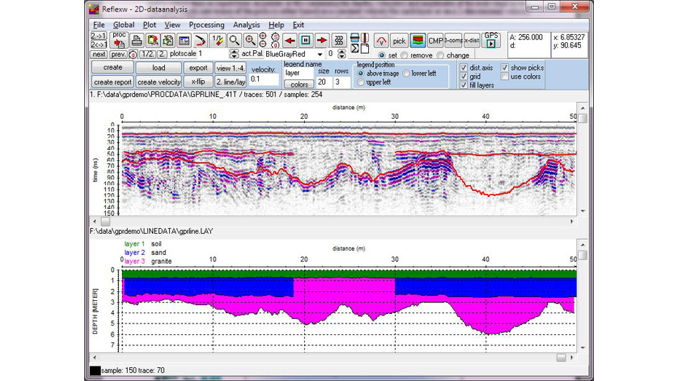
Velocity Analysis CMP gathers are stacked along trialvelocity hyperbolas and presented in timevelocity diagrams. Normal Moveout (NMO) correction NMO correction transforms a reflection record at offset x into a normal-incidence (x=0) record: 2 x 1 x t 0= t x t x V 2t x V 2 Stacking velocity NMO correction NMO correction stretches shallower and slower reflections stronger This affects the spectrum of the stack This distortion is controlled during processing by setting a limit in relative stretch (typically ~25%) 2 16) Residual statics Removes the remaining small traveltime variations caused by inaccurate statics or velocity model 15) Normal Moveout (NMO) correction Removes the effects of source-receiver separation from reflection records Transforms the records as if recorded at normal incidence. 14) Dip Moveout (DMO) correction Transforms the records so that the subsequent NMO+stack work well even in the presence of dipping reflectors. Wavelet shaping Shape of the source wavelet is estimated from autocorrelation of the data Time-variant spectral whitening (flattening within an estimated bandwidth) is applied A filter is designed to convert the wavelet into zero-phase Migrated stack before wavelet processing Migrated stack after wavelet processingĬMP Processing Sequence (continued) 13) Velocity analysis For each of the CMP gathers, determines the optimal stacking velocity. More on deconvolution in Filtering section later. 12) Moveout (Radon, τ-p, f-k) filtering Attenuates multiples, ground roll.ĭeconvolution Deconvolving (inverse) Filter Objectives: 1) Compress the wavelet into a sharp minimum- or zero-phase shape 2) Remove predictable (short-period multiple) part of the signal 3) Broaden (flatten) the spectrum. Converts the wavelet to zero-phase for viewing 11) Gather, CMP sort Often (in ProMax, Omega, Vista) done by using trace lookup tables instead of creating additional copies of the dataset. 10) Deconvolution or wavelet processing Compresses the wavelet in time, attenuates reverberations. 9) Trace balance Equalizes the variations in amplitudes caused by differences in coupling In true-amplitude processing, replaced with surface-consistent deconvolution. 7) Top, bottom, and surgical mute Eliminates (sets amplitude=0) the time intervals where strong non-reflection energy is present: First arrivals, ground roll, airwave.ĬMP Processing Sequence (continued) 8) Gain recovery Compensates geometrical spreading Based on a simple heuristic relation. 6) Refraction statics Builds a model for the shallow, low-velocity subsurface Compensates travel-time variations caused by the shallow velocities. Transforms the records as if recorded at a common horizontal datum surface. 5) Elevation statics Based on geometry information, compensates the travel-time variations caused by variations in source/receiver elevations.
#Reflex gpr demultiplex manual
3) Edit Removal of bad traces (noisy channels, poorly planted geophones, channels contaminated by power line noise, etc.).ĬMP Processing sequence (continued) 4) First arrival picking May be semi-automatic or manual Required for generation of refraction statics models and for designing the mutes.

2) Field Geometry Assignment of source-receiver coordinates, offsets, etc. ProMax, Focus, Omega, SU, Vista, etc., internal formats.

Universities: Stanford Exploration Project Seismic UNIX (Colorado School of Mines) FreeUSP (Amoco) SIOSEIS (Scrippts, marine) Our very ownĬMP Processing Sequence 1) Demultiplex, Vibroseis correlation, Gain recovery Conversion from file formats produced by field data loggers into processingoriented formats SEG-Y, SEG-2. Commercial: ProMAX (Landmark) Omega (Western Geophysical, marine) Focus (Paradigm) Amoco and almost every other company have their own Vista (Seismic Image Soft.). Seismic Processing Systems Usually geared to a particular type of application Mostly CMP reflection processing Land or marine, 2D or 3D. Importance of processing A line processed by several contractors British Petroleum Carless Exploration Clyde Petroleum Goal Petroleum Premier Consolidated Oilfields Tricentrol Oil Exploration Data reduction and editing Transformation into conveniently computer-manageable form Removal of bad records Gathering CMP sorting Filtering in time and space Attenuation of noise Imaging Final velocity and reflectivity image. Reflection Seismic Processing Objective - transform redundant reflection seismic records in the time domain into an interpretable depth image. Reflection Seismic Processing General CMP processing sequence Highlights of some key steps Reading: Sheriff and Geldart, Chapter 9


 0 kommentar(er)
0 kommentar(er)
